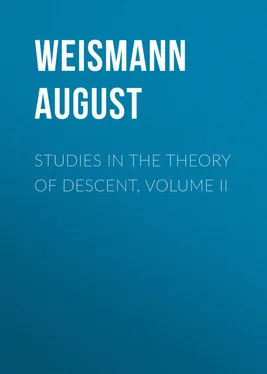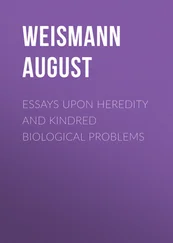August Weismann - Studies in the Theory of Descent, Volume II
Здесь есть возможность читать онлайн «August Weismann - Studies in the Theory of Descent, Volume II» — ознакомительный отрывок электронной книги совершенно бесплатно, а после прочтения отрывка купить полную версию. В некоторых случаях можно слушать аудио, скачать через торрент в формате fb2 и присутствует краткое содержание. Жанр: foreign_antique, foreign_prose, на английском языке. Описание произведения, (предисловие) а так же отзывы посетителей доступны на портале библиотеки ЛибКат.
- Название:Studies in the Theory of Descent, Volume II
- Автор:
- Жанр:
- Год:неизвестен
- ISBN:нет данных
- Рейтинг книги:4 / 5. Голосов: 1
-
Избранное:Добавить в избранное
- Отзывы:
-
Ваша оценка:
- 80
- 1
- 2
- 3
- 4
- 5
Studies in the Theory of Descent, Volume II: краткое содержание, описание и аннотация
Предлагаем к чтению аннотацию, описание, краткое содержание или предисловие (зависит от того, что написал сам автор книги «Studies in the Theory of Descent, Volume II»). Если вы не нашли необходимую информацию о книге — напишите в комментариях, мы постараемся отыскать её.
Studies in the Theory of Descent, Volume II — читать онлайн ознакомительный отрывок
Ниже представлен текст книги, разбитый по страницам. Система сохранения места последней прочитанной страницы, позволяет с удобством читать онлайн бесплатно книгу «Studies in the Theory of Descent, Volume II», без необходимости каждый раз заново искать на чём Вы остановились. Поставьте закладку, и сможете в любой момент перейти на страницу, на которой закончили чтение.
Интервал:
Закладка:
There are a very large number of species which possess very constant imagines and pupæ, but extremely variable larvæ. The following are the cases known to me: — Macroglossa Stellatarum , Fuciformis and Bombyliformis ; Chærocampa Elpenor , Celerio , and Nerii ; Deilephila Galii , Livornica , Hübn., Hippophaës , Vespertilio , and Zygophylli ; Sphinx Convolvuli ; Acherontia Atropos ; Smerinthus Ocellatus and Tiliæ ; Callimorpha Hera ; Cucullia Verbasci and Scrophulariæ .
Cases in which the variability depends entirely upon the pupa, while the larva and imago are extremely constant, are of great rarity. Vanessa Io is a case in point, the pupa being light or dark brown, or bright golden green, whilst in the two other stages scarcely any light shades of colour or variations in the very complicated marking are to be met with.
The facts thus justify the above view that the individual stages of development change independently – that a change occurring in one stage is without influence on the preceding and succeeding stages. Were this not the case no one stage could possibly become variable without all the other stages becoming so. Did there exist a correlation between larvæ, pupæ, and imagines of such a nature that every change in the larva entailed a corresponding change in the imago, as soon as a large number of larval characters became fluctuating ( i. e. as soon as this stage became variable), a large number of imaginal characters would necessarily also become fluctuating ( i. e. this stage would also become correspondingly variable).
There is one other interpretation which might perhaps be attempted from the point of view of the old doctrine of species. It might be said that it is a special property of certain larval or imaginal markings to be variable whilst others are constant, and since the larval and imaginal markings of a species are generally quite distinct, it may easily happen that a butterfly possessing markings having the property of constancy may belong to a caterpillar having variable markings.
There is a soul of truth underlying this objection, since it is true that the various forms of markings which occur in Lepidoptera apparently reach different degrees of constancy. If we speak of the constancy or variability of a species, a different meaning is attached to these expressions according as we are dealing e. g. with a species of Sphinx or a species of Arctia . That which in the latter would be estimated as a high degree of constancy, in the former would be taken as a considerable amount of variability. It is of interest, in connection with the question as to the causes of constancy, to note that the power of any form of marking to attain to a high degree of constancy is by no means inversely proportional to the complication of the marking, as would have been expected à priori .
Thus, the species of Sphinx and of allied genera possess on their fore-wings, which are mostly coloured with a mixture of dull grey, white and black, an exceedingly complicated arrangement of lines which, in constant species, show a high degree of uniformity: on the other hand, the checquered fore-wings of our Arctiidæ , which are far more coarsely marked, always show, even in the most constant species, well-marked individual differences. The different types of marking must therefore be measured by different standards.
But in granting this, we decidedly refute the statement that constancy and variability are inherent properties of certain forms of marking.
This reasoning is based on the simple fact that a given type of marking comprises both species of great constancy and of (relatively) great variability.
Thus, the fore-wings of Sphinx Ligustri and S. Convolvuli are extremely constant, whilst the very similarly marked Anceryx (Hyloicus) Pinastri is exceedingly variable. Similarly Deilephila Euphorbiæ is known by its great variability of colouring and marking, whilst D. Galii , which resembles this species so closely as to be sometimes confounded with it, possesses a high degree of constancy, and further, the Corsican and Sardinian D. Dahlii is very variable. Among the family Arctiidæ , Callimorpha Hera and the Alpine Arctia Flavia are cases of constancy, whilst A. Caja , which is so similar to the last species, is so generally variable that two perfectly identical specimens can scarcely be found together.
The same can be shown to hold good for the markings of caterpillars. Thus, the larva of D. Dahlii shows very considerable variability, whilst that of D. Galii is very constant in marking (disregarding the ground-colour). So also the larva of Vanessa Urticæ is very variable and that of V. Antiopa very constant, &c.
The great differences with respect to constancy or variability which are displayed by the different stages of one and the same species, must therefore find their explanation elsewhere than in the type of the marking itself. The explanation must be found in the circumstance that each stage changes independently of the others, and at different periods can enter a new phase of variability.
We are here led in anticipation to the main question: – Are changes produced by internal or external causes? is it the physical nature of the organism which is compelled to become remoulded spontaneously after the lapse of a certain period of time? or does such modification only occur when produced directly or indirectly by the external conditions of life?
In the cases before us the facts undoubtedly indicate a complete dependence of the transformations upon external conditions of life.
The independent appearance of variability in the separate stages of the metamorphosis might, however, be regarded as only apparent. It might still be attempted to attribute the changes to a purely inherent cause, i. e. , to a phyletic vital force, by assuming that the latter acts periodically in such a manner that at first one and then the following stage becomes variable, until finally the entire species is transformed.
There is but little to be said in reply to this if we once take refuge in entirely unknown forces, the operation of which can be arbitrarily conceived to be either constant or periodic.
But granting that such a transforming power exists and acts periodically, the variability must always pass over the different stages in a fixed direction, like a wave over the surface of water – imago, pupa, and larva, or larva, pupa, and imago, must successively become variable. Cases like that of Araschnia Prorsa , in which all three stages are variable, may certainly be thus explained, but those instances in which the larva and imago are extremely variable, and the pupa quite constant, are entirely inexplicable from this point of view.
The latter can, however, be very simply explained if we suppose the changes to be dependent upon external influences. From this standpoint we not only see how it is possible that an intermediate stage should remain uninfluenced by the changes which affect the two other stages, but we can also understand why it should just be the pupal stage that plays this part so frequently. If we ask why most pupæ are constant and are relatively but very slightly variable, the answer will be found in the facts that all pupæ which remain concealed in the earth or inside plants ( Sesiidæ ), or which are protected by stout cocoons, show complete constancy, whilst any considerable amount of variability occurs only in those pupæ which are suspended or openly exposed. This is closely connected with a fact to which I have called attention on a former occasion, 2 2 “Über den Einfluss der Isolirung auf die Artbildung.” Leipzig, 1872, p. 20.
viz., that dimorphism occurs in certain pupæ, but only in those which are openly exposed and which are therefore visible to their foes. I am only acquainted with such cases among the pupæ of butterflies, and it is likewise only among these that I have found any considerable amount of variability.
Интервал:
Закладка:
Похожие книги на «Studies in the Theory of Descent, Volume II»
Представляем Вашему вниманию похожие книги на «Studies in the Theory of Descent, Volume II» списком для выбора. Мы отобрали схожую по названию и смыслу литературу в надежде предоставить читателям больше вариантов отыскать новые, интересные, ещё непрочитанные произведения.
Обсуждение, отзывы о книге «Studies in the Theory of Descent, Volume II» и просто собственные мнения читателей. Оставьте ваши комментарии, напишите, что Вы думаете о произведении, его смысле или главных героях. Укажите что конкретно понравилось, а что нет, и почему Вы так считаете.












